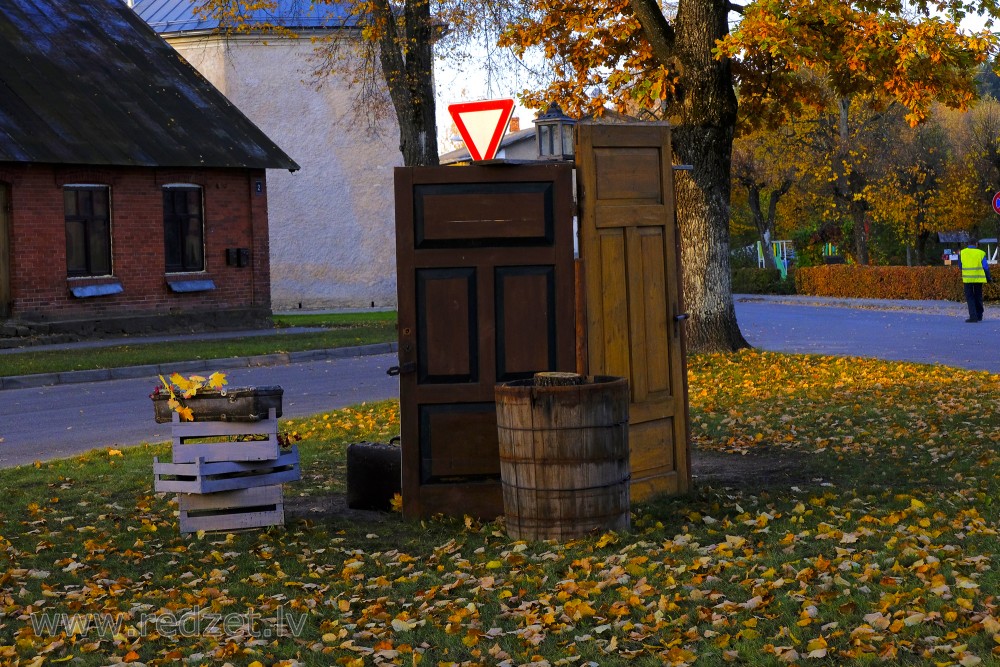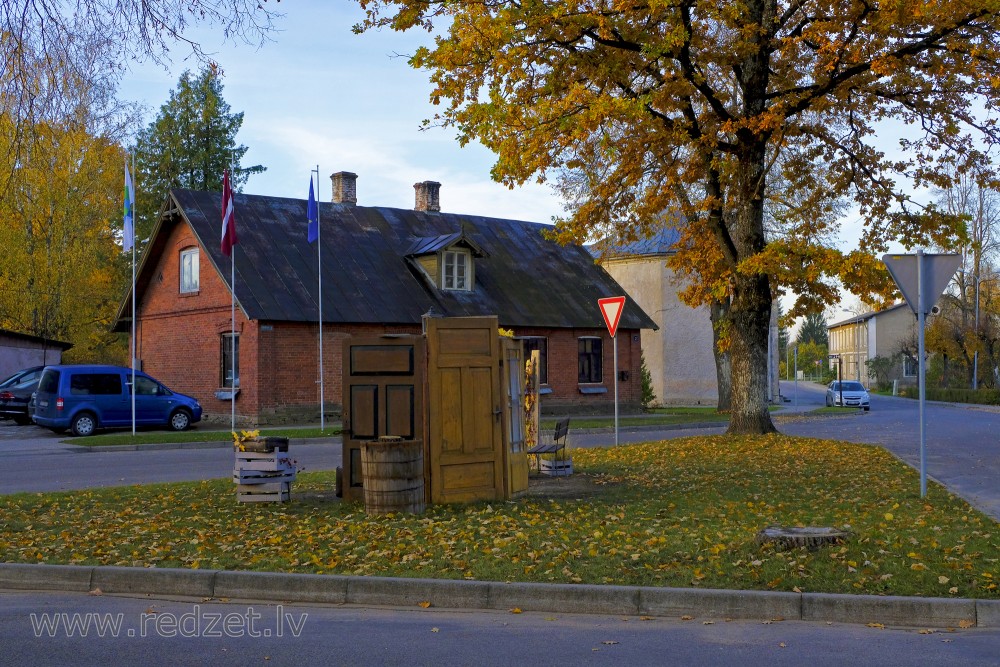Door
A door is a moving mechanism used to block off and allow access to, an entrance to or within an enclosed space, such as a building, room or vehicle. Doors normally consist of one or two solid panels, with or without windows, that swing using hinges horizontally. These hinges are attached to the door's edge but there are also doors that slide, fold or spin. The main purpose of a door is to control physical access.
Doors are significant in preventing the spread of fire and as a barrier to noise. Many doors are equipped with locking mechanisms to allow entrance to certain people and keep out others.
When opened, doors can allow people, animals, ventilation or light to pass through. The door is used to control the physical atmosphere within a space by enclosing the air drafts, so that interiors may be more effectively heated or cooled. When closed, a door normally impedes the transfer of air from one side to the other. Similar structures that do allow air to be transferred through some form of a grillwork are called gates.
Doors may have an aesthetic purpose in creating an impression of what lies beyond; for example, keeping administrative and factory areas of a building separate. In less formal settings, doors may also be seen as a sign of the desire for privacy. As a form of courtesy and civility, people often knock before opening a door and entering a room. Some doors even have designated "knockers." like the one in the photo located next to this text.
Doors are often symbolically endowed with ritualistic purposes. For example, being granted access to a door, including the guarding or receiving of the key to that door, may have special significance. Similarly, doors and doorways frequently appear in literature and the arts in metaphorical or allegorical context, often as a portent of change.
In most cases the interior side of a door matches its exterior side but, in some other cases, there are sharp contrasts between the two sides, such as in the case of a vehicle door.
Design and styles
There are many kinds of doors, with different purposes. The most common type is the single-leaf door, which consists of a single rigid panel that fills the doorway. There are many variations on this basic design, such as the double-leaf door or double door and French windows, which have two adjacent independent panels hinged on each side of the doorway.
- A half door or Dutch door or stable door is divided in half horizontally. Traditionally the top half can be opened to allow a horse or other animal to be fed, while the bottom half remains closed to keep the animal inside. This style of door has been adapted for homes.
- Saloon doors are a pair of lightweight swing doors often found in public bars, and especially associated with the American west. Saloon doors, also known as cafe doors, often use bidirectional hinges that close the door regardless of which direction it is opened by incorporating springs. Saloon doors that only extend from knee-level to chest-level are known as batwing doors.
- A blind door, Gibb door, or jib door has no visible trim or operable components. It is designed to blend with the adjacent wall in all finishes, and visually to be a part of the wall, a disguised door.
- A French door consists of a frame around one or more transparent or translucent panels (called lights or lites) that may be installed singly, in matching pairs, or even as series. A matching pair of these doors is called a French window, as it resembles a door-height casement window. When a pair of French doors is used as a French window, the application does not generally include a central mullion (as do some casement window pairs), thus allowing a wider unobstructed opening. The frame typically requires a weather strip at floor level and where the doors meet to prevent water ingress. An espagnolette bolt may allow the head and foot of each door to be secured in one movement. The slender window joinery maximizes light into the room and minimizes the visual impact of the doorway joinery when considered externally. The doors of a French window often open outward onto a balcony, porch, or terrace and they may provide an entrance to a garden.
- A louvred door has fixed or movable wooden fins (often called slats or louvers) which permit open ventilation while preserving privacy and preventing the passage of light to the interior. Being relatively weak structures, they are most commonly used for wardrobes and drying rooms, where security is of less importance than good ventilation, although a very similar structure is commonly used to form window shutters. Double louvred doors were introduced into Seagate, built in Florida in 1929 by Gwendolyn and Powel Crosley, that provided the desired circulation of air with an added degree of privacy in that it is impossible to see through the fins in any direction.
- A composite door is a single leaf door that can be solid or with glass, and is usually filled with high density foam. In the United Kingdom, it is common for composite doors to be certified to BS PAS 23/24[10] and be compliant with Secured by Design, an official UK police initiative.
- A steel security door is one which is made from strong steel, often for use on vaults and safe rooms to withstand attack. These may also be fitted with wooden outer panels to resemble standard internal and external doors.
- A flush door is a completely smooth door, having plywood or MDF fixed over a light timber frame, the hollow parts of which are often filled with a cardboard core material. Skins can also be made out of hardboards, the first of which was invented by William H Mason in 1924. Called Masonite, its construction involved pressing and steaming wood chips into boards. Flush doors are most commonly employed in the interior of a dwelling, although slightly more substantial versions are occasionally used as exterior doors, especially within hotels and other buildings containing many independent dwellings.
- A moulded door has the same structure as that of flush door. The only difference is that the surface material is a moulded skin made of MDF. Skins can also be made out of hardboards.
- A ledge and brace door often called board and batten doors are made from multiple vertical boards fixed together by two or more horizontal timbers called ledges (or battens)and sometimes kept square by additional diagonal timbers called braces.
- A wicket door is a pedestrian door built into a much larger door allowing access without requiring the opening of the larger door. Examples might be found on the ceremonial door of a cathedral or in a large vehicle door in a garage or hangar.
- A bifold door is a unit that has several sections, folding in pairs. Wood is the most common material, and doors may also be metal or glass. Bifolds are most commonly made for closets, but may also be used as units between rooms. Bi-fold doors are essentially now doors that let the outside in. They open in concert; where the panels fold up against one another and are pushed together when opened. The main door panel (often known as the traffic door) is accompanied by a stack of panels that fold very neatly against one another when opened fully, which almost look like room dividers.
- A sliding glass door, sometimes called an Arcadia door or patio door, is a door made of glass that slides open and sometimes has a screen (a removable metal mesh that covers the door).
- Australian doors are a pair of plywood swinging doors often found in Australian public houses. These doors are generally red or brown in color and bear a resemblance to the more formal doors found in other British Colonies' public houses.
- A false door is a wall decoration that looks like a window. In ancient Egyptian architecture, this was a common element in a tomb, the false door representing a gate to the afterlife. They can also be found in the funerary architecture of the desert tribes (e.g., Libyan Ghirza).
- A doormat (also called door mat) is a mat placed typically in front of or behind a door of a home. This practice originated so that mud and dirt would be less prevalent on floors inside a building.



